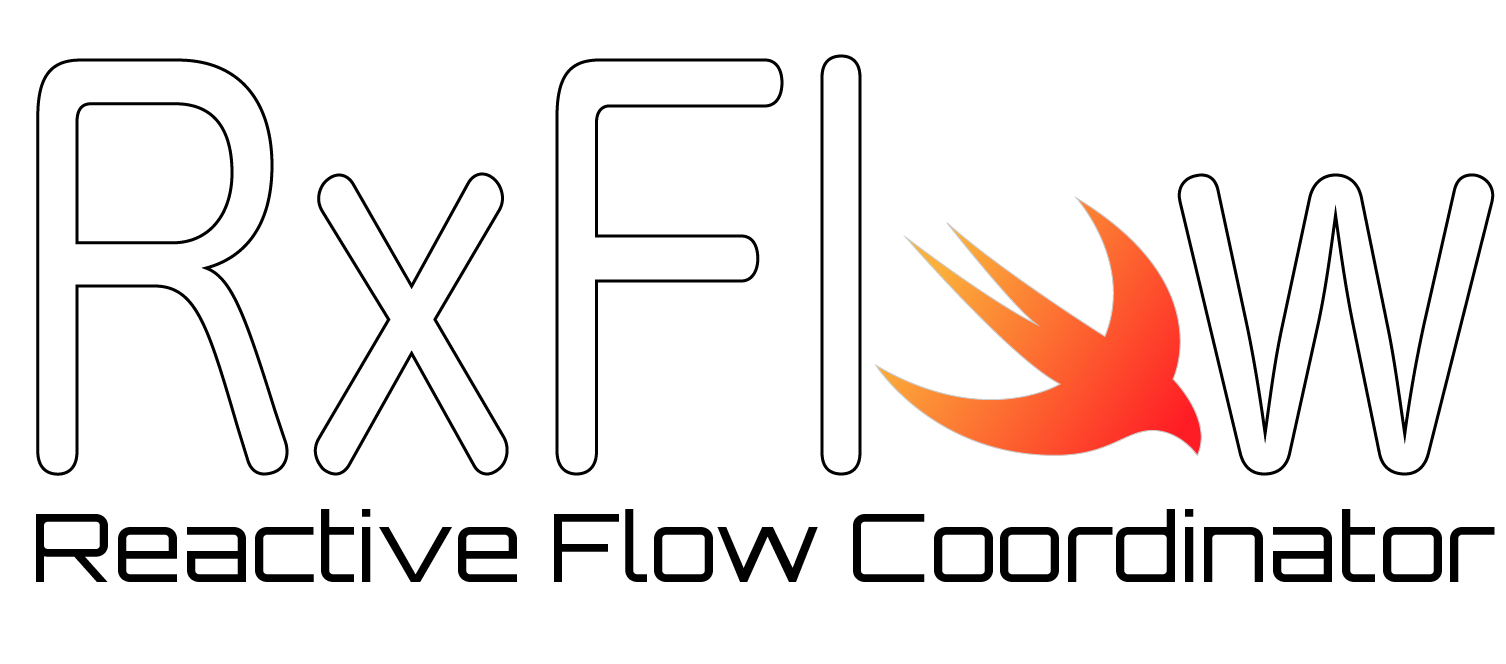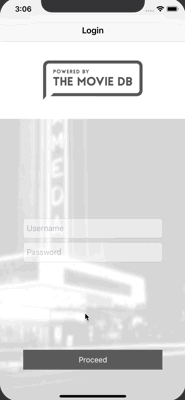 |
|
|---|---|
| Travis CI | |
| Frameworks |   |
| Platform |  |
| Licence |  |
RxFlow is a navigation framework for iOS applications based on a Flow Coordinator pattern.
This README is a short story of the whole conception process that led me to this framework.
You will find a very detail explanation of the whole project on my blog:
The Jazzy documentation can be seen here as well: Documentation
There are two major changes that must be taken care of if you want to use the v1.1.0 when coming from an older version:
- Flowable has been replaced by NextFlowItem. It's exactly the same idea between those 2 names, but "Flowable" was too much related to a Protocol naming convention. The Flow.navigate(to:) function has to return a NextFlowItems, which is an enum that represents different possibilities of NextFlowItem (multiple, one, none, ...). Take a look at the code snippets below to see some examples.
- In order to improve RxFlow consistency, it seemed obvious that a Flow that presents a UIViewController also HAS to dismiss it. In previous versions, a child Flow was dismissed by itself and not by the Flow that presented it. In the Demo Application you will find an example with the WishlistFlow dismissing the SettingsFlow for the settingsDone Step.
There are two major changes that must be taken care of if you want to use the v1.3.0 when coming from an older version:
- NextFlowItems.stepNotHandled has been removed for the sake of simplicity. If you want a received step to have no effect at all in a navigate(to:) function, all you need to do is returning a NextFlowItems.none value. It means that no new Stepper will be registered in the Coordinator.
- NextFlowItems.end(withStepForParentFlow: Step) allows to explicitly tell the Coordinator that you want to dismiss the current Flow. You can pass the Step you want the parent Flow to receive in its navigate(to:) function. That is where you will dismiss the child Flow root Presentable. It can be also used to pass data to the parent ** Flow** thanks to an enum parameter (withStepForParentFlow could be something like: DemoStep.loginIsComplete(idUser: xxx))
The DemoApp has been updated to implement those changes. It shows how to swap between 2 Flows attached to the root Window.
Regarding navigation within an iOS application, two choices are available:
- Use the builtin mechanism provided by Apple and Xcode: storyboards and segues
- Implement a custom mechanism directly in the code
The disadvantage of these two solutions:
- Builtin mechanism: navigation is relatively static and the storyboards are massive. The navigation code pollutes the UIViewControllers
- Custom mechanism: code can be difficult to set up and can be complex depending on the chosen design pattern (Router, Coordinator)
- Promote the cutting of storyboards into atomic units to enable collaboration and reusability of UIViewControllers
- Allow the presentation of a UIViewController in different ways according to the navigation context
- Ease the implementation of dependency injection
- Remove every navigation mechanism from UIViewControllers
- Promote reactive programming
- Express the navigation in a declarative way while addressing the majority of the navigation cases
- Facilitate the cutting of an application into logical blocks of navigation
In your Cartfile:
github "RxSwiftCommunity/RxFlow"In your Podfile:
pod 'RxFlow'The Coordinator pattern is a great way to organize the navigation within your application. It allows to:
- remove the navigation code from UIViewControllers
- reuse UIViewControllers in different navigation contexts
- ease the use of dependency injection
To learn more about it, I suggest you take a look at this article: (Coordinator Redux).
To me, the Coordinator pattern has some drawbacks:
- you have to write the coordination mechanism each time you bootstrap an application
- there can be a lot of boilerplate code because of the delegation pattern that allows to communicate with Coordinators
RxFlow is a reactive implementation of the Coordinator pattern. It has all the great features of this architecture, but introduces some improvements:
- makes the navigation more declarative
- provides a built-in Coordinator that handles the navigation flows you've declared
- uses reactive programming to address the communication with Coordinators issue
There are 6 terms you have to be familiar with to understand RxFlow:
- Flow: each Flow defines a navigation area within your application. This is the place where you declare the navigation actions (such as presenting a UIViewController or another Flow)
- Step: each Step is a navigation state in your application. Combinations of Flows and Steps describe all the possible navigation actions. A Step can even embed inner values (such as Ids, URLs, ...) that will be propagated to screens declared in the Flows
- Stepper: it can be anything that can emit Steps. Steppers will be responsible for triggering every navigation actions within the Flows
- Presentable: it is an abstraction of something that can be presented (basically UIViewController and Flow are Presentable). Presentables offer Reactive observables that the Coordinator will subscribe to in order to handle Flow Steps in a UIKit compliant way
- NextFlowItem: it is a simple data structure that combines a Presentable and a Stepper. It tells the Coordinator what will be the next thing that will produce new Steps in your Reactive mechanism
- Coordinator: once the developer has defined the suitable combinations of Flows and Steps representing the navigation possibilities, the job of the Coordinator is to mix these combinations in a consistent way.
As Steps are seen like some navigation states spread across the application, it seems pretty obvious to use an enum to declare them
enum DemoStep: Step {
case apiKey
case apiKeyIsComplete
case movieList
case moviePicked (withMovieId: Int)
case castPicked (withCastId: Int)
case settings
case settingsDone
case about
}The following Flow is used as a Navigation stack. All you have to do is:
- declare a root UIViewController on which your navigation will be based
- implement the navigate(to:) function to transform a Step into a navigation action
The navigate(to:) function returns a NextFlowItems. This is how the next navigation actions will be produced (the Stepper defined in a NextFlowItem will emit the next Steps)
class WatchedFlow: Flow {
var root: Presentable {
return self.rootViewController
}
private let rootViewController = UINavigationController()
private let service: MoviesService
init(withService service: MoviesService) {
self.service = service
}
func navigate(to step: Step) -> NextFlowItems {
guard let step = step as? DemoStep else { return NextFlowItems.none }
switch step {
case .movieList:
return navigateToMovieListScreen()
case .moviePicked(let movieId):
return navigateToMovieDetailScreen(with: movieId)
case .castPicked(let castId):
return navigateToCastDetailScreen(with: castId)
default:
return NextFlowItems.none
}
}
private func navigateToMovieListScreen () -> NextFlowItems {
let viewModel = WatchedViewModel(with: self.service)
let viewController = WatchedViewController.instantiate(with: viewModel)
viewController.title = "Watched"
self.rootViewController.pushViewController(viewController, animated: true)
return NextFlowItems.one(flowItem: NextFlowItem(nextPresentable: viewController, nextStepper: viewModel))
}
private func navigateToMovieDetailScreen (with movieId: Int) -> NextFlowItems {
let viewModel = MovieDetailViewModel(withService: self.service, andMovieId: movieId)
let viewController = MovieDetailViewController.instantiate(with: viewModel)
viewController.title = viewModel.title
self.rootViewController.pushViewController(viewController, animated: true)
return NextFlowItems.one(flowItem: NextFlowItem(nextPresentable: viewController, nextStepper: viewModel))
}
private func navigateToCastDetailScreen (with castId: Int) -> NextFlowItems {
let viewModel = CastDetailViewModel(withService: self.service, andCastId: castId)
let viewController = CastDetailViewController.instantiate(with: viewModel)
viewController.title = viewModel.name
self.rootViewController.pushViewController(viewController, animated: true)
return NextFlowItems.none
}
}In theory a Stepper, as it is a protocol, can be anything (a UIViewController for instance) by I suggest to isolate that behavior in a ViewModel or so. For simple cases (for instance when we only need to bootstrap a Flow with a first Step and don't want to code a basic Stepper for that), RxFlow provides a OneStepper class.
class WatchedViewModel: Stepper {
let movies: [MovieViewModel]
init(with service: MoviesService) {
// we can do some data refactoring in order to display things exactly the way we want (this is the aim of a ViewModel)
self.movies = service.watchedMovies().map({ (movie) -> MovieViewModel in
return MovieViewModel(id: movie.id, title: movie.title, image: movie.image)
})
}
// when a movie is picked, a new Step is emitted.
// That will trigger a navigation action within the WatchedFlow
public func pick (movieId: Int) {
self.step.accept(DemoStep.moviePicked(withMovieId: movieId))
}
}Of course, it is the aim of a Coordinator. As a Flow is a Presentable, a Flow can launch one other Flow or even several other Flows.
For instance, from the WishlistFlow, we launch the SettingsFlow in a popup.
private func navigateToSettings () -> NextFlowItems {
let settingsStepper = SettingsStepper()
let settingsFlow = SettingsFlow(withService: self.service, andStepper: settingsStepper)
Flows.whenReady(flow: settingsFlow, block: { [unowned self] (root: UISplitViewController) in
self.rootViewController.present(root, animated: true)
})
return NextFlowItems.one(flowItem: NextFlowItem(nextPresentable: settingsFlow, nextStepper: settingsStepper))
}For a more complex case, see the MainFlow.swift file in which we handle a UITabBarController.
The coordination process is pretty straightfoward and happens in the AppDelegate.
class AppDelegate: UIResponder, UIApplicationDelegate {
let disposeBag = DisposeBag()
var window: UIWindow?
var coordinator = Coordinator()
let movieService = MoviesService()
lazy var appFlow = {
return AppFlow(with: self.movieService)
}()
func application(_ application: UIApplication,
didFinishLaunchingWithOptions launchOptions: [UIApplicationLaunchOptionsKey: Any]?) -> Bool {
guard let window = self.window else { return false }
// listen for Coordinator mechanism is not mandatory
coordinator.rx.didNavigate.subscribe(onNext: { (flow, step) in
print ("did navigate to flow=\(flow) and step=\(step)")
}).disposed(by: self.disposeBag)
// when the MainFlow is ready to be displayed, we assign its root the the Window
Flows.whenReady(flow: appFlow, block: { [unowned window] (flowRoot) in
window.rootViewController = flowRoot
})
// The navigation begins with the MainFlow at the apiKey Step
// We could also have a specific Stepper that could decide if
// the apiKey should be the fist step or not
coordinator.coordinate(flow: appFlow, withStepper: OneStepper(withSingleStep: DemoStep.apiKey))
return true
}
}As a bonus, Coordinator offers a Rx extension that allows you to track the navigation actions (Coordinator.rx.willNavigate and Coordinator.rx.didNavigate).
A demo application is provided to illustrate the core mechanisms. Pretty much every kind of navigation is addressed. The app consists of:
- an AppFlow that represents the main navigation. This Flow will handle the OnboardingFlow and the DashboardFlow
- an OnBoardingFlow that represents a 2 steps onboarding wizard in a UINavigationController. It will only be displayed the first time the app is used
- a DashboardFlow that handles the Tabbar for the WishlistFlow and the WatchedFlow
- a WishlistFlow that represents a navigation stack of movies that you want to watch
- a WatchedFlow that represents a navigation stack of movies that you've already seen
- a SettingsFlow that represents the user's preferences in a master/detail presentation

RxFlow relies on:
- SwiftLint for static code analysis (Github SwiftLint)
- RxSwift to expose Steps as Observables the Coordinator can react to (Github RxSwift)
- Reusable in the Demo App to ease the storyboard cutting into atomic ViewControllers (Github Reusable)